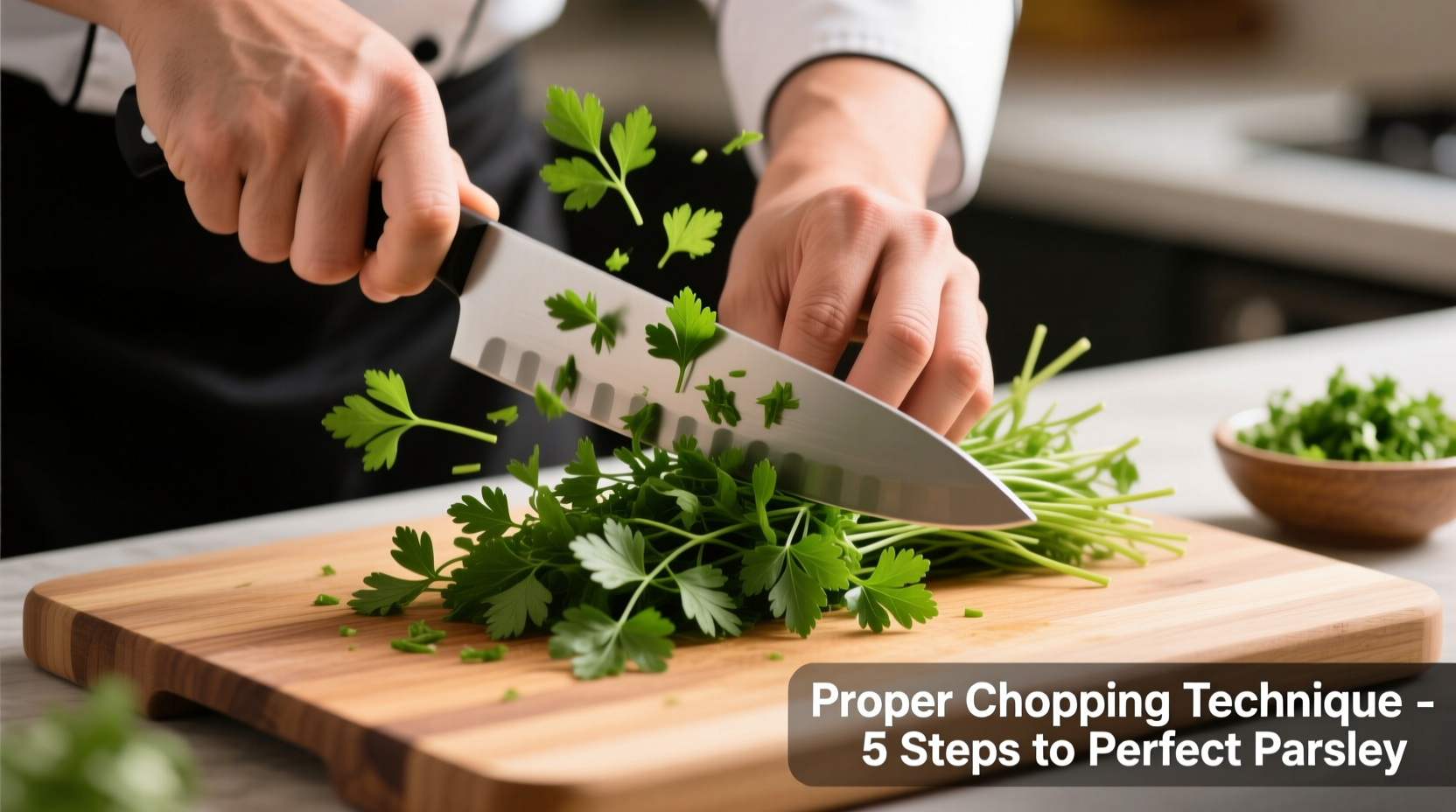Chopping parsley properly requires the right technique to maintain its vibrant color and fresh flavor while avoiding the common pitfalls of bruising or uneven cuts. The key is using a sharp chef's knife with a rocking motion while keeping the leaves dry and properly gathered.
Why Proper Parsley Chopping Matters
Many home cooks struggle with parsley slipping on the cutting board or ending up with inconsistent pieces that either disappear into dishes or remain too large. Proper technique affects both presentation and flavor release. When parsley is chopped correctly, it releases essential oils gradually during cooking rather than all at once, creating more balanced flavor profiles in your dishes.
Essential Tools for Perfect Parsley Chops
Before you begin, gather these kitchen essentials:
- A sharp 8-inch chef's knife (dull knives crush rather than cut)
- A stable, non-slip cutting board (wood or composite)
- A clean kitchen towel for drying
- A small bowl for finished parsley
| Knife Type | Best For | Not Recommended For |
|---|---|---|
| Chef's Knife (8-inch) | Most efficient for large quantities, proper rocking motion | Fine mincing tasks |
| Paring Knife | Small amounts or precision work | Chopping more than 1/4 cup |
| Rock Chop Herb Scissors | Quick chopping when presentation isn't critical | Dishes requiring uniform texture |
Step-by-Step Parsley Chopping Technique
Preparation: Wash and Dry Thoroughly
Improperly dried parsley is the #1 reason for slipping during chopping. Follow these steps:
- Rinse parsley under cold water to remove dirt
- Shake vigorously to remove excess water
- Roll in a clean kitchen towel to absorb moisture
- Spread on paper towels for 5-10 minutes if extremely wet
According to the Culinary Institute of America's Professional Chef textbook, "moisture is the enemy of clean herb cuts"—wet herbs won't hold their shape during chopping and release too much chlorophyll, turning dishes muddy green.
The Gather-and-Chop Method
This professional technique prevents parsley from scattering across your board:
- Gather dried parsley sprigs into a tight bundle
- Hold the bundle firmly with your non-knife hand, curling fingertips inward
- Position knife tip on the board, handle slightly elevated
- Use a smooth rocking motion from tip to heel
- After 3-4 chops, rotate bundle 90 degrees and repeat
- Continue until desired consistency is achieved

When to Use the Rock Chop Technique
For larger quantities (more than 1 cup), the rock chop method proves most efficient. This technique evolved from traditional French culinary practices where speed and consistency were paramount in professional kitchens. Unlike the gather-and-chop method, the rock chop keeps your knife in constant contact with the board:
- Finely mince a small portion using gather-and-chop
- Use this minced parsley as a "base" on your cutting board
- Add remaining parsley on top of this base
- Hold knife tip down with one hand, use other hand on spine
- Rock knife rapidly while moving forward gradually
- Stop before parsley becomes a paste
Avoid These Common Parsley Chopping Mistakes
Even experienced cooks make these errors that compromise parsley quality:
- Using a dull knife - crushes rather than cuts, releasing too much chlorophyll
- Chopping while wet - causes slipping and inconsistent results
- Over-chopping - turns parsley to mush, accelerating oxidation
- Using a rocking chair motion - inconsistent cuts from improper knife angle
- Chopping stems with leaves - stems require separate treatment for best results
Parsley Stem Utilization Guide
Don't discard parsley stems—they contain concentrated flavor. Here's how to use them properly:
- For soups and stocks: chop coarsely and add early in cooking
- For sauces: blend stems with oil for vibrant green bases
- For garnish: reserve tender top portions for fine mincing
- For compound butter: finely mince both stems and leaves
Storage Solutions for Chopped Parsley
Properly stored, chopped parsley maintains freshness significantly longer. The University of California Division of Agriculture and Natural Resources recommends these storage methods:
- Short-term (1-3 days): Place in airtight container lined with paper towel
- Medium-term (4-7 days): Store in glass jar with 1/2 inch water, cover with plastic bag
- Long-term (up to 1 month): Freeze in olive oil in ice cube trays
Never store chopped parsley in direct sunlight or near heat sources, as this accelerates oxidation and flavor loss. The ideal storage temperature is 32-36°F (0-2°C).
Culinary Applications for Perfectly Chopped Parsley
Different dishes require different parsley textures. Match your chop to the application:
- Fine chop (1-2mm): Garnishes, finishing touches, delicate sauces
- Medium chop (2-4mm): Most cooked dishes, stuffings, compound butters
- Rough chop (4-6mm): Stocks, braises, rustic dishes where texture matters less
Professional chefs often employ a technique called "double-chopping" where they initially chop coarsely, gather the parsley, then perform a finer chop. This two-stage process prevents overworking the herb in a single session.
When Not to Chop Parsley
Some culinary applications actually benefit from whole or minimally processed parsley:
- When making bouquet garni for slow-cooked dishes
- As a bed for grilled meats or fish
- When creating herb-infused oils (whole leaves extract better)
- For decorative plating where individual leaf structure matters
Understanding these context boundaries helps you determine when chopping is appropriate versus other preparation methods.
Mastering Parsley Chopping: Practice Makes Perfect
Like any knife skill, consistent parsley chopping improves with practice. Start with small amounts and focus on maintaining proper hand position and knife angle. Within a few weeks of regular practice, you'll develop muscle memory that makes parsley chopping quick and effortless.











 浙公网安备
33010002000092号
浙公网安备
33010002000092号 浙B2-20120091-4
浙B2-20120091-4